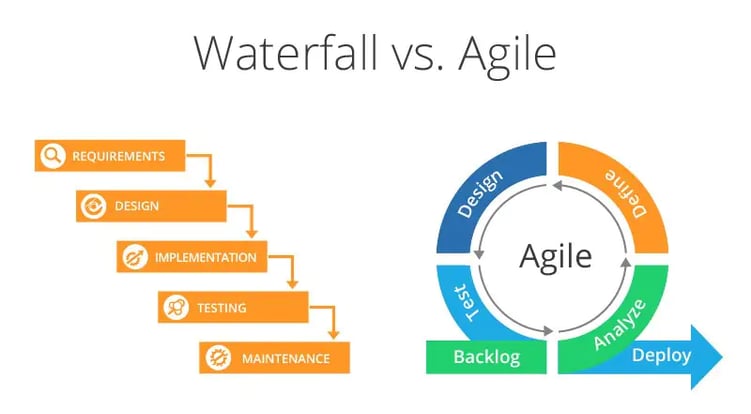Agile vs. Waterfall: Which Methodology is Right for Your Project?
Nicolás Koriakos
9/24/20243 min read
When it comes to software development, one of the key decisions project managers face is choosing the right methodology. Two of the most popular approaches are Agile and Waterfall. Each has its strengths, weaknesses, and ideal use cases.
In this blog post, we’ll explore both methodologies, compare their advantages, and help you determine which one might be the best fit for your project.
Understanding Waterfall
Waterfall is a linear and sequential project management methodology. In this approach, a project is broken down into distinct phases: requirements, design, development, testing, and deployment. Each phase must be completed before moving on to the next. Waterfall follows a strict order with little room for flexibility.
Pros of Waterfall:
Clear structure: Since all phases are planned in advance, it’s easier to manage and monitor progress.
Easy to understand: Waterfall is straightforward, making it easier for stakeholders and team members to follow.
Defined expectations: Clients have a clear understanding of the project timeline, deliverables, and budget from the start.
Cons of Waterfall:
Limited flexibility: Once a phase is completed, it's difficult to make changes, which can be problematic if project requirements evolve.
Late testing: Testing occurs at the end of the process, meaning errors or issues may only be caught after significant work has already been completed.
Not ideal for complex or evolving projects: Waterfall is less effective in projects that require adaptability or where requirements may change over time.


Understanding Agile
Agile, in contrast, is an iterative and flexible approach to project management. Work is broken down into small increments or sprints, usually lasting 2-4 weeks. Each sprint delivers a working piece of software, allowing for ongoing feedback, adaptation, and continuous improvement throughout the project.
Pros of Agile:
Flexibility and adaptability: Agile allows for changes to be made at any point in the development process based on feedback, new information, or evolving requirements.
Continuous feedback: With each sprint, stakeholders and clients can review progress and provide input, ensuring the project stays aligned with their needs.
Faster delivery: Agile emphasizes delivering functional components frequently, so clients see value early and often.
Cons of Agile:
Less predictability: Due to its iterative nature, it can be harder to estimate the full scope of the project, including timeline and budget.
Requires collaboration: Agile relies on constant communication and collaboration between developers, stakeholders, and clients.
Scope creep risk: Since changes are welcomed throughout the project, there’s a risk of the project growing beyond initial expectations.
Key Differences Between Agile and Waterfall
Flexibility: Waterfall is rigid, whereas Agile is highly adaptable.
Project Phases: Waterfall follows a strict, linear path, while Agile works in iterative cycles.
Feedback: Waterfall usually has client feedback at the end, whereas Agile involves constant feedback throughout the project.
Testing: In Waterfall, testing happens after development; in Agile, it happens continuously.
Which Methodology is Right for Your Project?
Choosing between Agile and Waterfall depends on the specific needs and circumstances of your project. Here are some factors to consider:
Project Size and Complexity:
If your project has clearly defined requirements and a fixed scope, Waterfall might be a better fit.
For complex projects where requirements are expected to evolve or where you need flexibility, Agile is a stronger option.
Stakeholder Involvement:
Waterfall is ideal for projects where stakeholders have little time to engage during development.
Agile works well when stakeholders are available for continuous feedback and collaboration throughout the process.
Time and Budget Constraints:
Waterfall provides clear timelines and budget estimates from the start.
Agile can offer quicker deliverables, but may make budgeting and timelines more fluid.
Risk Management:
If your project needs thorough upfront planning and risk mitigation, Waterfall’s structured approach can be beneficial.
Agile’s flexibility reduces risk by allowing early identification and resolution of issues, but it requires a willingness to embrace change.
Conclusion
Both Agile and Waterfall methodologies offer valuable frameworks for managing software development projects. If your project demands a structured approach with minimal changes, Waterfall could be the right choice.
On the other hand, if you need adaptability, faster deliverables, and constant feedback, Agile is likely the better path. Ultimately, the best methodology will depend on your project’s scope, the involvement of stakeholders, and how adaptable your team is to changes.
